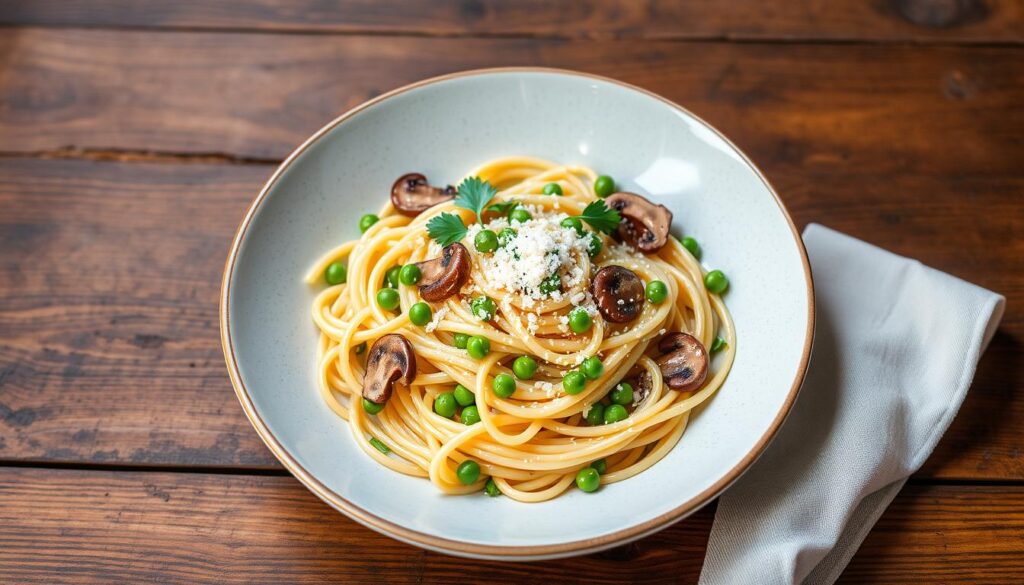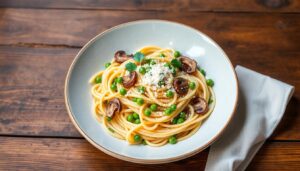I love cooking at home and always wanted to make a vegetarian carbonara. It had to be as good as the original. After some trial and error, I found a way to make a vegetarian carbonara that’s just as tasty. It’s ready in 20 minutes, and you won’t miss the meat.
The secret ingredient is mushrooms. They add a meaty flavor and texture that’s perfect for a vegetarian dish. Paired with a creamy sauce and the right pasta, this vegetarian carbonara is a hit with everyone.
Table of Contents
Why Try This Meatless Pasta Carbonara
Are you searching for a tasty and healthy carbonara pasta alternative? This meatless pasta carbonara recipe is perfect. It keeps the creamy, savory flavors of carbonara but without the meat. Here are the top reasons to give this vegetarian version a try.
Health Benefits of Going Meatless
Choosing to eat less meat can be good for your health. Meatless pasta carbonara has less saturated fat and cholesterol. It’s better for your heart. Also, adding veggies boosts your intake of vitamins, minerals, and fiber.
Time-Saving Advantages
Making carbonara without meat is quick and easy. It’s ready in 20 minutes or less. This is great for busy nights when you need a fast, tasty meal.
Cost-Effective Meal Solution
This meatless carbonara is also budget-friendly. It uses plant-based proteins and veggies, saving you money. You can enjoy a delicious pasta dish without spending a lot.
So, why not try this meatless pasta carbonara? It’s healthy, quick, and affordable. It’s sure to become a favorite in your household.
“Eating less meat can have a positive impact on your health and the environment. This vegetarian carbonara recipe is a delicious way to make that change.”
Essential Ingredients for Vegetarian Carbonara
Creating a tasty vegetarian carbonara recipe starts with picking the right ingredients. We’ll use vegetables instead of meat to make a dish that’s just as good. Let’s explore the key ingredients that make your carbonara veggie a hit.
- Pasta: Choose a long, thin pasta like spaghetti or linguine for the best sauce.
- Eggs: Eggs are the main attraction, making the sauce creamy when mixed with cheese.
- Cheese: Use Parmesan or Pecorino Romano for a salty, umami flavor.
- Mushrooms: Cremini or shiitake mushrooms add an earthy, savory taste.
- Garlic: Fresh garlic boosts the flavor and aroma.
- Olive oil: Use high-quality extra virgin olive oil for cooking and adding richness.
- Black pepper: Freshly ground black pepper adds a subtle heat and depth.
By choosing and mixing these ingredients carefully, you’ll make a vegetarian carbonara recipe full of flavor. Get ready to enjoy a meatless pasta dish that will impress everyone.
Kitchen Tools You’ll Need
Preparing a tasty vegetarian carbonara requires the right tools. You’ll need basic items and some optional gadgets. Let’s look at what you need to make this dish a hit.
Basic Equipment Requirements
You’ll start with a few key items. A large pot or saucepan is needed for boiling pasta. A skillet or sauté pan is for cooking veggies. A sharp knife is for chopping ingredients.
A colander or strainer is also a must for draining pasta.
Optional Helpful Gadgets
While not necessary, some tools can make prep easier. A high-quality food processor or blender helps with a smooth sauce. A handheld cheese grater is useful for shredding cheese.
| Essential Cookware | Optional Helpful Gadgets |
|---|---|
|
|
With these tools, making vegetarian carbonara at home is easy. The right equipment makes the dish a breeze to prepare.
Choosing the Perfect Pasta Type
When making a delicious vegetarian carbonara, picking the right pasta is key. You might choose classic spaghetti or the thicker fettuccine. Each pasta type adds its own texture and taste to the dish.
For a traditional veggies carbonara, go for spaghetti or linguine. These long noodles work well with the creamy egg sauce. They let the veggies mix in smoothly, making the dish feel luxurious.
For a heartier meal, try fettuccine or penne. These thicker noodles can hold more sauce and veggies. They’re great for those who want a more filling carbonara with veggies.
Choosing pasta should match your taste and the veggies you use. Try different shapes to find the best fit for your dish.
| Pasta Type | Texture | Recommended Use |
|---|---|---|
| Spaghetti/Linguine | Long, slender noodles | Traditional carbonara with veggies |
| Fettuccine/Penne | Broader, thicker noodles | Heartier carbonara with veggies |
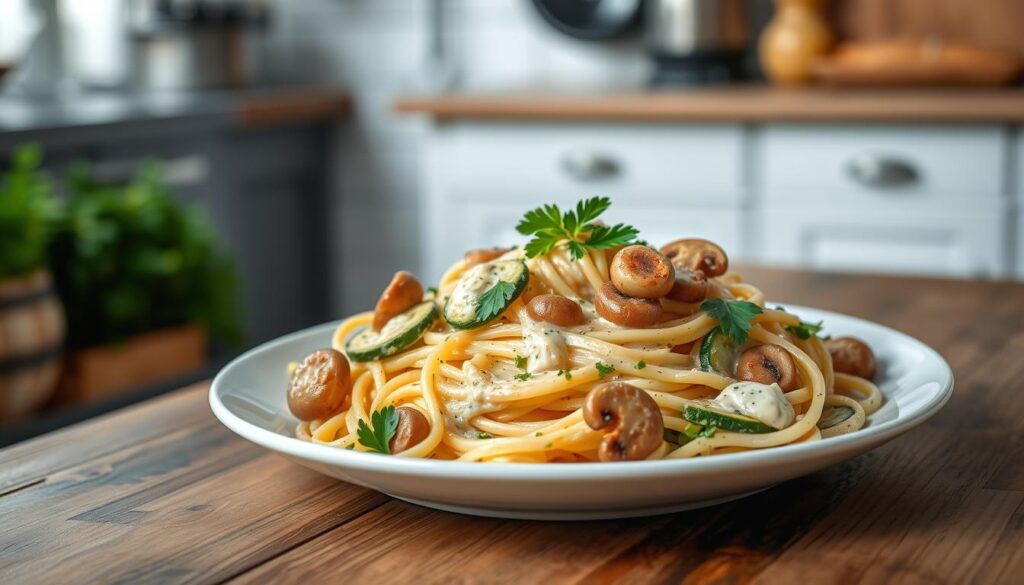
“The right pasta can elevate a simple carbonara with veggies into a culinary masterpiece.”
The Secret to Creamy Egg Sauce
Making a creamy egg sauce is key to a great vegetarian carbonara recipe. The trick is to control the temperature and avoid scrambling the eggs. With a few tips, you can make a smooth sauce that makes your dish stand out.
Temperature Control Tips
The temperature of your ingredients is very important. Make sure the pasta is hot and the egg mixture is room temperature. This helps the eggs thicken slowly without scrambling.
Whisk the eggs and cheese well before adding the hot pasta. This way, the sauce cooks gently and stays smooth.
Preventing Scrambled Eggs
- Avoid adding the egg mixture to the pan over direct heat, as this can lead to scrambling.
- Whisk the eggs vigorously to incorporate air and create a smooth, emulsified texture.
- Remove the pan from the heat as soon as the sauce begins to thicken, and continue stirring to prevent overcooking.
- If the sauce starts to look grainy or curdled, quickly remove it from the heat and whisk in a splash of hot pasta water to smooth it out.
With practice and these tips, you’ll make a vegetarian carbonara with a creamy egg sauce. It will coat every pasta bite perfectly.
Vegetable Substitutes for Pancetta
Creating a tasty carbonara veggie or meatless pasta carbonara is easy. You can swap pancetta for many tasty vegetables. These options add texture and unique flavors to your dish.
Mushrooms are a great choice. Crimini or shiitake mushrooms add an earthy taste. Zucchini, with its mild flavor, also works well in the pasta.
Sun-dried tomatoes bring a Mediterranean twist. Their sweetness and chewiness contrast nicely with the creamy sauce. Roasted red peppers or caramelized onions add depth too.
When using these vegetables, think about cooking time. Mushrooms and zucchini need longer to get flavorful. Sun-dried tomatoes should be added last to keep their texture.
Exploring vegetable-based carbonara opens up new flavors. It makes a delicious, healthy dish that’s good for you and your taste buds.
Mastering the Vegetarian Carbonara Technique
Making the perfect vegetarian carbonara needs careful timing and the right mix of ingredients. Focus on these points to make your meatless pasta dish taste amazing and feel great.
Timing Your Cooking Steps
Timing is key when making vegetarian carbonara. First, boil a big pot of salted water for your pasta. Then, cook the pasta as the package says, keeping it al dente. While the pasta cooks, mix the egg yolks, cheese, and seasonings in a bowl. Set it aside for now.
Combining Ingredients Successfully
When the pasta is done, drain it and put it back in the hot pot. Add the egg mixture and stir constantly. This makes a creamy sauce. The pasta’s heat will cook the eggs without scrambling them.
It’s important to work fast. This way, the egg mixture blends well with the hot pasta. With practice, you’ll get better at mixing these ingredients. Your vegetarian carbonara will taste just as good as the traditional one.
Common Mistakes to Avoid
Making the perfect vegetarian carbonara recipe is a fun challenge. But, there are a few mistakes that can mess up your dish. I’ve learned to avoid these to get a creamy, tasty veggie carbonara every time.
One big mistake is overcooking the pasta. You want it to be al dente, with a bit of bite. Another mistake is using cold eggs, which can make the sauce look like scrambled eggs. Make sure your eggs are room temperature before adding them.
- Overcooking the pasta
- Using cold eggs for the sauce
- Failing to temper the eggs properly
- Skimping on the cheese
- Not sautéing the vegetables long enough
Tempering the eggs is also key. It keeps them smooth and prevents curdling. And don’t forget the cheese – lots of Parmesan or pecorino is needed for that creamy texture.
Lastly, make sure to sauté your veggie substitutes until they’re browned and caramelized. Skipping this step can make the flavor flat.
By avoiding these mistakes, you’ll make a vegetarian carbonara that’s sure to impress. Happy cooking!
Making Your Carbonara Sauce Extra Creamy
To make the perfect carbonara veggie dish, you need more than just ingredients. You must focus on the details. This includes choosing the right cheese and mastering mixing techniques. Let’s dive into the secrets for a creamy carbonara veggie sauce.
Cheese Selection Guide
The cheese you pick is key to a creamy carbonara veggie sauce. While Pecorino Romano is traditional, you can try other hard, aged cheeses. Here are some good options:
- Parmesan: A classic that adds a nutty, savory taste.
- Asiago: This cheese is semi-hard, creamy, and slightly tangy.
- Grana Padano: Similar to Parmesan but with a milder flavor.
Proper Mixing Methods
Getting the right carbonara veggie sauce consistency is all about finesse. Here are some tips for a smooth, creamy sauce:
- Use room-temperature ingredients: This prevents eggs from scrambling.
- Temper the eggs: Whisk a bit of hot pasta water into the eggs to avoid curdling.
- Add pasta water gradually: The starch in the water makes the sauce creamy. Add it slowly, mixing well, until it’s right.
- Mix off the heat: Stir the sauce after combining ingredients to avoid overcooking the eggs.
By using these techniques, you’ll make a carbonara veggie sauce that’s rich, creamy, and delicious.
Best Vegetable Combinations
Creating a tasty meatless pasta carbonara can be enhanced by choosing the right vegetables. The right veggie mix can make your dish not only taste better but also be healthier. Let’s look at some top vegetable pairings to make your carbonara with veggies and meatless pasta carbonara even better.
Mushrooms and Peas
Mushrooms bring a rich, earthy flavor that pairs well with the sweetness of peas. This combo adds a nice texture and flavor to your vegetarian carbonara. Plus, the peas add a bright color, making the dish look great.
Asparagus and Cherry Tomatoes
For a lighter version, try asparagus and cherry tomatoes. The tomatoes’ bright flavor balances the creamy egg sauce. Asparagus adds a nice crunch and extra nutrients.
Roasted Butternut Squash and Spinach
Make your carbonara with veggies even better with roasted butternut squash and spinach. The squash’s sweetness goes well with the egg sauce. Spinach adds color and lots of vitamins and minerals.
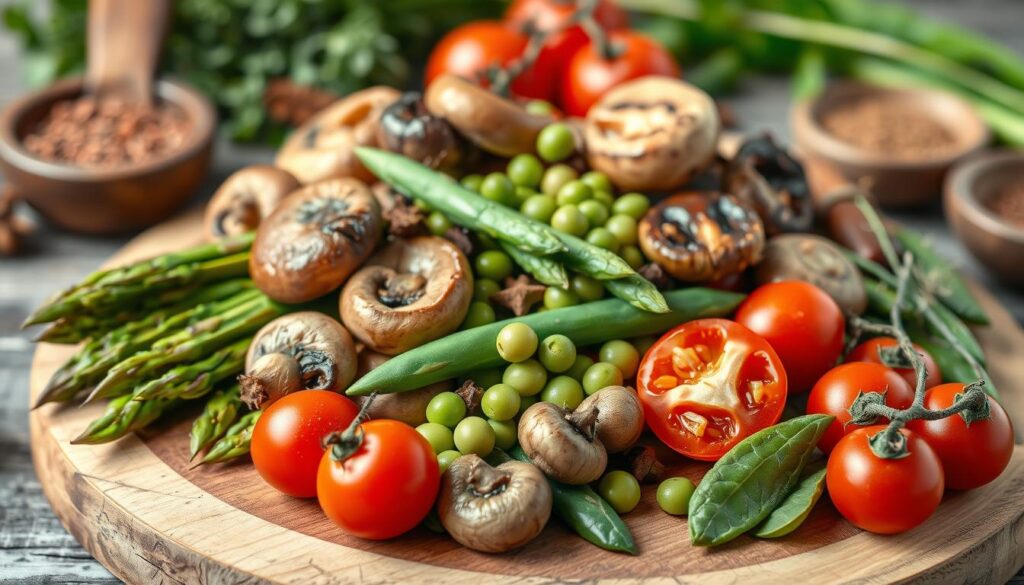
Creating a great meatless pasta carbonara is all about trying different veggie mixes. Find the perfect mix of flavors and textures that you love. This way, you can take your carbonara to new heights in the kitchen.
Storing and Reheating Tips
Enjoying a delicious vegetarian carbonara dish is just the beginning. Properly storing leftovers and reheating them is key. This ensures you get the most out of your meal. Let’s explore the best practices for handling your creamy meatless carbonara.
Storing Leftover Vegetarian Carbonara
To keep your vegetarian carbonara fresh and safe, follow these storage tips:
- Let the dish cool completely before putting it in an airtight container.
- Refrigerate leftovers within 2 hours of cooking for food safety.
- Stored properly, your vegetarian carbonara can last up to 4 days in the fridge.
- Don’t leave the dish at room temperature for too long. The egg-based sauce can spoil quickly.
Reheating Vegetarian Carbonara
When reheating your vegetarian carbonara, follow these easy steps:
- Put the desired portion in a microwave-safe dish.
- Add a splash of milk or vegetable broth to rehydrate the sauce.
- Cover the dish loosely with a microwave-safe lid or plate.
- Reheat in the microwave at 50% power for 1-2 minutes, stirring halfway through, until heated through.
- Or, you can reheat it on the stovetop over low heat, stirring often, until warmed.
The key to successful reheating is to go low and slow. This prevents the egg-based sauce from curdling and the pasta from drying out.
Nutritional Information
The vegetarian carbonara recipe is packed with nutrients. It’s a healthier choice than the traditional version. Yet, it doesn’t lose out on taste or texture.
Protein Content
Eggs and cheese are the main protein sources in this vegetarian carbonara. They offer 17 grams of protein per serving. This is perfect for those wanting more plant-based protein.
Caloric Breakdown
- Calories per serving: 380
- Fat: 18 grams
- Carbohydrates: 38 grams
- Fiber: 3 grams
This vegetarian carbonara has 100 fewer calories and 5 grams less fat than the traditional version. It’s a better choice for your health. Whole-wheat pasta and veggies add more fiber, helping with digestion and overall health.
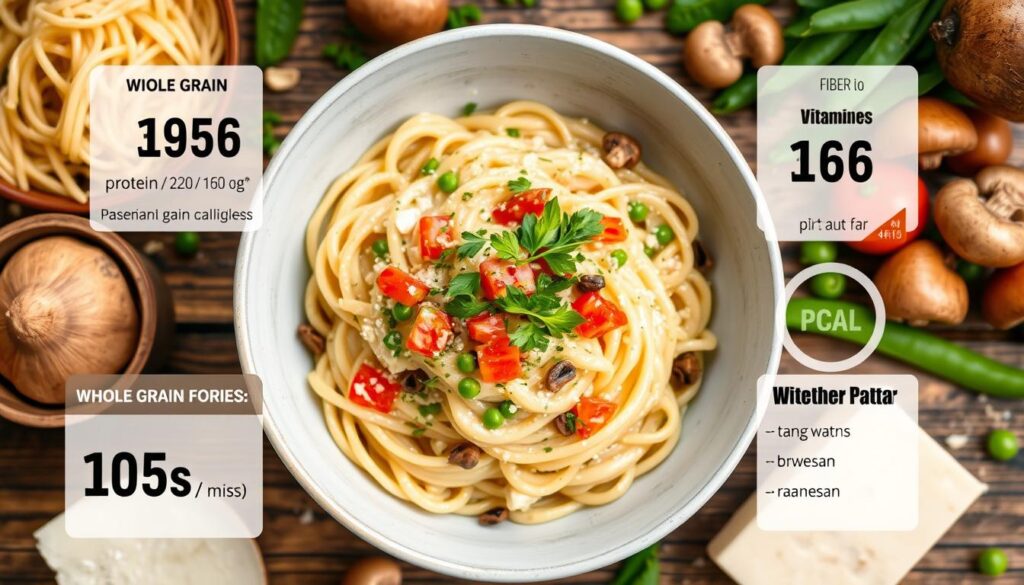
“This vegetarian carbonara is a game-changer. It’s just as creamy and satisfying as the original, but with a healthier nutritional profile. I’m amazed at how much protein and fiber it packs in without any meat.”
If you’re a vegetarian or just want to eat more plant-based, this vegetarian carbonara recipe is a tasty and healthy choice. It won’t let you down.
Serving Suggestions
There are many ways to serve your vegetarian carbonara. This dish goes well with different sides, making it a full meal. Here are some ideas to make your carbonara veggie even better.
A fresh salad is a great match. The crisp greens and tangy dressing balance the creamy sauce. Try a simple mixed green salad or a Caesar salad with homemade croutons.
Garlic bread is another excellent choice. Its garlic and buttery taste contrast nicely with the pasta. Serve it warm for the best flavor.
Adding roasted vegetables makes the meal more filling. Mushrooms, asparagus, or a mix of veggies add color and crunch.
| Serving Suggestion | Description |
|---|---|
| Mixed Green Salad | A light, crisp salad with a tangy vinaigrette dressing complements the rich carbonara veggie perfectly. |
| Garlic Bread | The aromatic garlic and buttery goodness of the bread provide a delightful contrast to the pasta’s creaminess. |
| Roasted Vegetables | Juicy roasted mushrooms, tender asparagus, or a medley of seasonal veggies can add a beautiful pop of color and a satisfying crunch to the carbonara veggie dish. |
Be creative with your presentation. Add parsley, Parmesan, or olive oil for a stunning dish. Serve it in a pasta bowl or on a plate for a feast for the eyes.
Try these serving ideas to make your carbonara veggie a complete meal. Enjoy the mix of flavors and textures in every bite.
Wine Pairing Recommendations
Finding the right wine for your vegetarian carbonara is key. You want a wine that complements the dish without taking over. The carbonara should be the main attraction, not the wine.
For a classic vegetarian carbonara, a crisp white wine is best. Sauvignon Blanc or Pinot Grigio works well. Their acidity and fruitiness cut through the creamy sauce and highlight the veggies. Dry Riesling or unoaked Chardonnay are also great choices.
If you prefer red, choose a light-to-medium bodied wine. Pinot Noir or Sangiovese are excellent picks. Their acidity and tannins enhance the dish without overwhelming it.
| Wine Varietal | Flavor Profile | Pairing Recommendation |
|---|---|---|
| Sauvignon Blanc | Crisp, herbaceous, citrusy | Pairs well with the creaminess and vegetables in vegetarian carbonara |
| Pinot Grigio | Light, refreshing, slightly fruity | Complements the delicate flavors of the dish |
| Pinot Noir | Light-bodied, bright acidity, subtle tannins | Balances the richness of the carbonara without overpowering it |
| Sangiovese | Medium-bodied, high acidity, moderate tannins | Pairs well with the vegetable components of the dish |
Choose a wine that makes your vegetarian carbonara shine. Experiment to find the perfect match. It will elevate your meatless pasta dish to new levels.
Variations of Carbonara with Veggies
The classic carbonara recipe is a delightful Italian pasta dish. It doesn’t have to be limited to traditional ingredients. By adding various vegetables, we can make flavorful and nutritious vegetarian carbonara variations. These cater to different dietary needs.
One of my favorite ways is to swap pancetta for sautéed zucchini or bell peppers. These vegetables offer a similar texture and umami flavor. They also add a fresh and colorful element to the dish.
For a heartier option, I’ve tried roasted Brussels sprouts or tender broccoli florets. They pair beautifully with the creamy egg-based sauce.
I’ve also explored using plant-based protein sources like crumbled tofu or diced tempeh. These ingredients add texture and nutrition. They help mimic the savory qualities of the original pancetta.
By playing with different pasta shapes, like spiralized zucchini noodles or whole wheat spaghetti, I can customize the carbonara. This suits various dietary needs and preferences.
